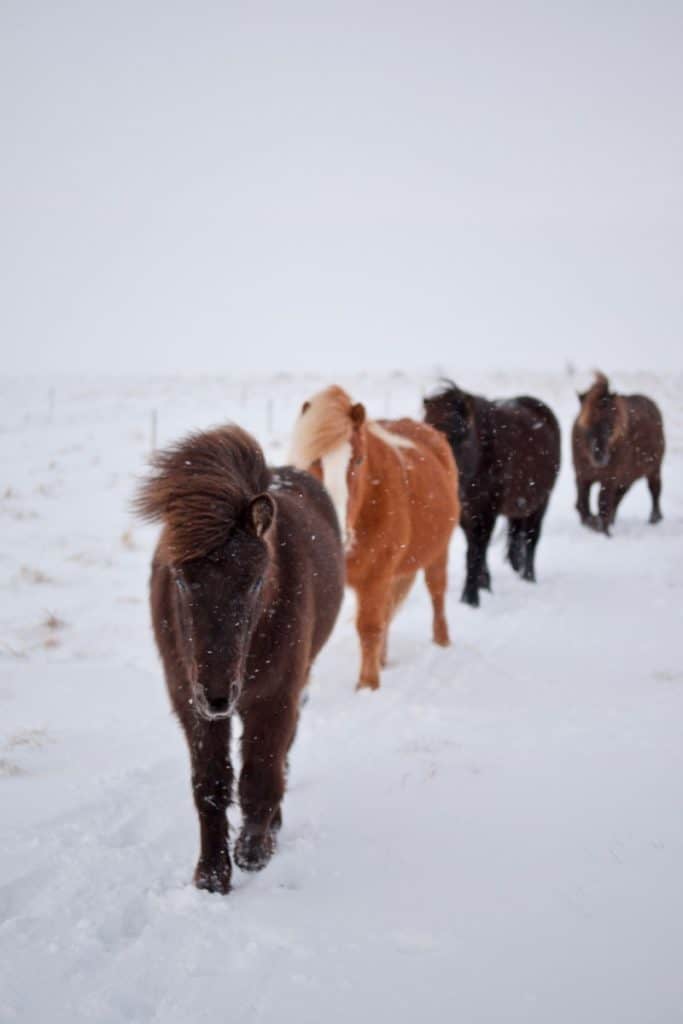
For those of us that live in places where the winter months come complete with frost bites and Rudolph-colored noses and where we will make any excuse to escape inside, it’s no wonder we ask ourselves if horses also get cold. Even in places with less extreme winters, a quick drop in temperature can affect a horse, so how do we know if a horse is feeling cold and what can we do to care for them and keep them warm during the winter?
Horses are usually very resistant to cold weather, however, factors such as the length of their fur coat, wind strength, air humidity, and the horses’ age and general state impact how easily it can stay warm in cold temperatures. If a horse shivers over a longer period of time or his core temperature drops below 99.5°F (37.5°C), measures should be taken to bring his temperature back up.
Temperature regulation in Horses
Horses have a thermoneutral zone in which they do not need to expend any extra energy to maintain their body temperature. The lower critical temperature is a temperature at the lower end of the thermoneutral zone at which a horse needs to use extra energy to maintain his body heat (source). The lower critical temperature for a horse with a good winter coat is usually around 41° F (-8° C), but this depends on what temperatures he is accustomed to as well as age and overall condition.
How Do I Know if My Horse is Cold?
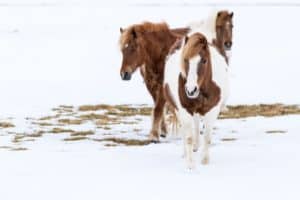
So how can we actually identify if a horse is cold? Shivering over extended periods of time (and particularly if other horses around are not shivering) can be a sign that a horse is cold. When a horse shivers, it uses muscles in order to heat up the body. This can be done to ‘kick-start’ their heat production when experiencing a quick temperature drop, however, it will then taper off as the core temperature comes up. If it persists, the quickest way to warm up a horse is by making him move, bring him inside, put on a warm blanket or a combination of these.
To check if a horse is cold, you can also do a temperature spot check. The normal temperature range of an average horse is 99.5-101.3°F (37.5-38.5°C), but this can vary slightly from horse to horse. The core temperature of a horse will also be lower in the mornings and higher in the evenings (after the horse has been moving around, eating and potentially exercising). It’s, therefore, a good idea to take your horse’s temperature at the same time of day and on a regular basis in order to know what level is normal for your horse, so that irregularities can be identified with more confidence.
If you are unsure of how to take the temperature of a horse, this video gives a thorough explanation of the process.
What Happens if a Horse Gets Cold?
We can look at a horse’s energy balance in the same way as the human metabolism. In order to maintain a steady weight (or in this case, energy level) there needs to be a balance between what is consumed and what is used. When a horses’ core temperature drops to a level where he is getting cold, the body will start using energy to stay within the thermoneutral zone. If this energy is not balanced out by higher food intake, the horse will over time burn into its fat layers and lose weight. Maintenance energy needs increase by 2.5% – 6% for each Celsius degree below a horses’ lower critical temperature and it is recommended to up the quantity of forage (not grain) during winter to make up for the additional energy they will have to use to stay warm.
How Cold is Too Cold for Horses to be Outside?
Horses are far better adapted to the cold than we are and can withstand very cold temperatures under the right conditions. If it is so cold that pipes freeze and you are unable to provide them with tepid water or if you can physically see the horses shiver persistently, then perhaps wait to turn them out until the temperature gets a little higher. This is however rare. Generally speaking, horses enjoy the outside air and greatly benefit from it both physically and mentally. They also have much longer nasal passages than humans, which allows the air to heat up before reaching their lungs, making breathing in cold air less uncomfortable than it can be for us.
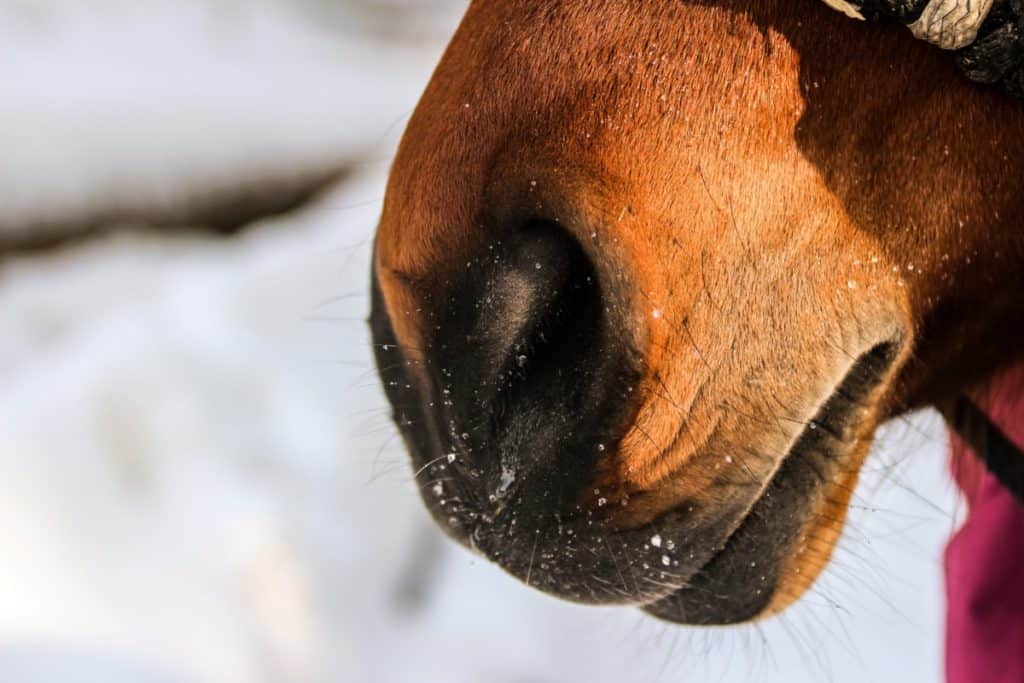
How to Keep Horses Warm in Cold Weather
It is primarily the horse’s fur coat that keeps him warm during winter. The fur coat grows thicker as fall comes along, and once temperatures drop it ‘fluffs up’, or more scientifically put, piloerection happens, which is essentially the same mechanism as when humans get goosebumps. This makes the hairs stand up and creates a layer of insulation around the body. So, as long as the horse has a thick winter coat and can stay dry, he is usually able to maintain his body temperature naturally.
Shelter
Elements that flatten the fur to the skin, such as strong winds, rain or humidity, will prevent that protective layer from appearing and allow the cold air to penetrate the fur coat, consequently cooling the horse down. This is why having access to shelter is so important when horses are turned out so they can stay dry. A shelter does not need to be very advanced but does need to provide good protection from the elements.
Use of blankets

All horses will develop a thicker fur coat once temperatures drop, however some horses are naturally more adapted to cold temperatures than others. A Shetland pony will withstand the cold much better than an Arabian horse which originally hails from a very different climate, so depending on the thickness of the coat and the temperatures the horse is used to, a blanket might be necessary.
Some riders will also opt to trim horses that do heavy work during the winter months to allow sweat to dry faster and make the grooming process more manageable. These horses will also need to have blankets on during winter, usually both inside and outside.
Blankets will press the fur coat down and prevent the fur from ‘fluffing up’; it is, therefore, important that it is thick enough to keep the horse warm and that there are no leaks.
If you are in need of updating your horses’ blanket wardrobe, these are the rugs and blankets we swear by and use. Living with Nordic weather conditions, our standards are really high for these products, especially for those winter and rain rugs!
Increase hay rations
Due to the extra energy a horse uses to stay warm during cold weather it is advised to increase forage rations accordingly.
Can Cold Weather Cause Colic in Horses?
Cold weather is not a direct cause of colic in horses, but conditions during winter affect how horses eat and move, which in turn increases the risk of digestion issues.
Horses drink less water in winter
On average, a 1000-pound (450 kg) horse needs about 10 gallons (38 liters) of water each day. In summer, horses will usually naturally up their intake of water due to the heat and also get a good position of their hydration needs covered from the grass they eat in the pasture. Lush grass can contain up to 75% water. Hay in comparison provides about 10% hydration, so the reduction in intake from food needs to be balanced out by a higher intake of water.
This is why horses should be encouraged to drink as much as possible in winter, so it is important to make sure they have fresh warm water to drink at all times. Hydration helps the digestive system function properly and without it, things can slow down and cause issues in the intestines that can lead to colic.
Horses need more energy in winter
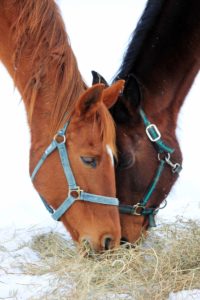
As mentioned, horses use a larger portion of their energy to stay warm when it’s cold, which means they require more forage to refill their reserves. Some chose to increase grain levels for their horse, however, the process of ingesting and digesting grain does not produce as much heat as the microbial fermentation of forage will.
Eating more means a higher risk of food collecting and getting stuck in the digestive system.
Horses move less in winter
Typically, horses move less during the colder months as they will often spend more time inside and be ridden less, which means less exercise. Movement is important for gut mobility and keeps food moving through the digestive tract.
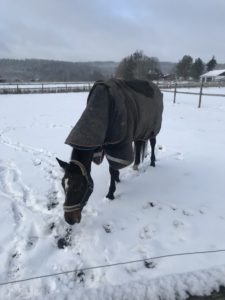
The combination of higher food intake, less water intake, and less exercise is what puts a horse at a higher risk of colic and why colic occurrences are more common in the winter months. We can help prevent them by making sure to turn out our horses, give them exercise and ensure they drink sufficiently.
So, in summary, don’t be afraid to turn your horse out when the chill passes your comfort level. Your horse is well-adapted to withstand cooler temperatures. Just make sure he is sufficiently protected through a thick fur coat or a warm rug as well as a good shelter with forage and water readily available.
This article is accurate and true to the best of the author’s knowledge. It is not meant to substitute diagnosis, prognosis, treatment or any type of medical advice for humans or horses. Animals exhibiting signs and symptoms of distress should be seen by a veterinarian immediately.


